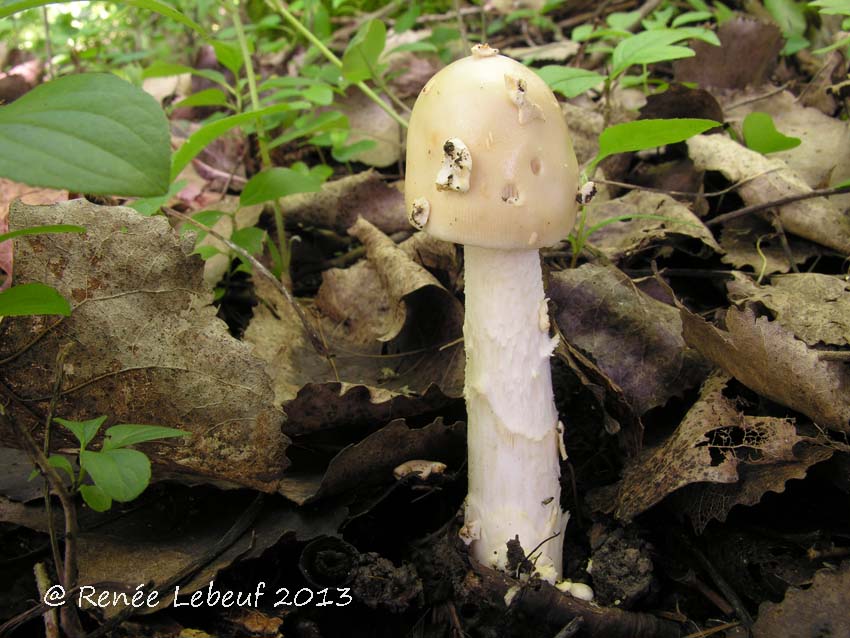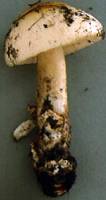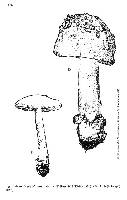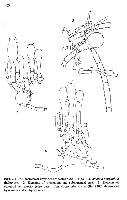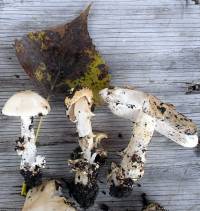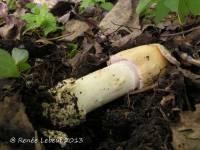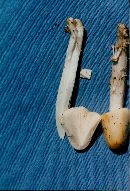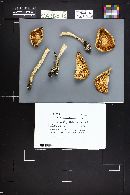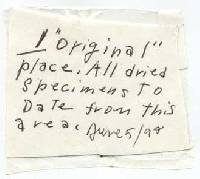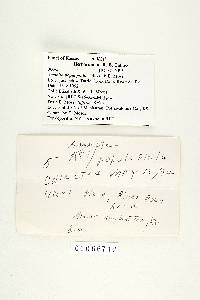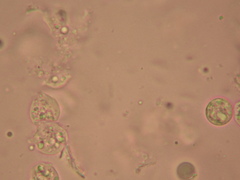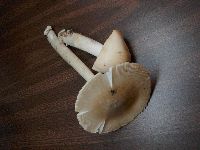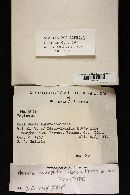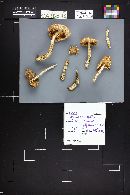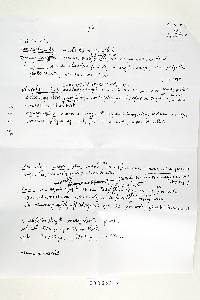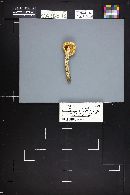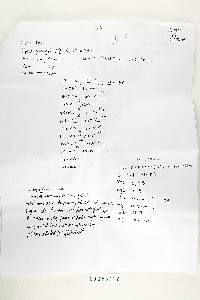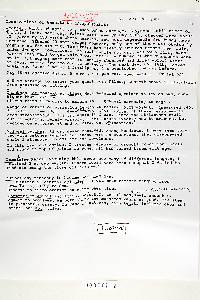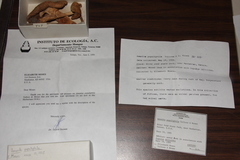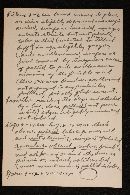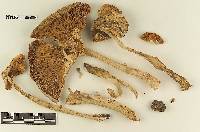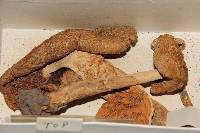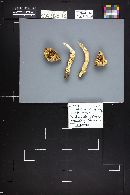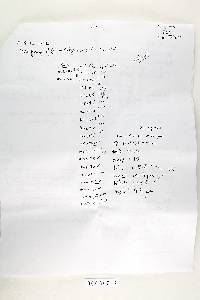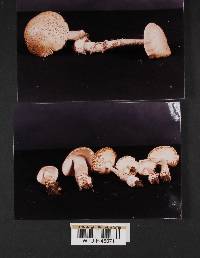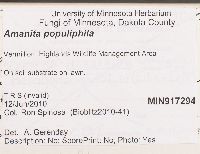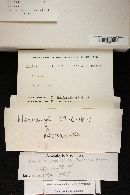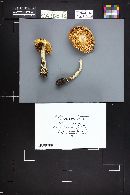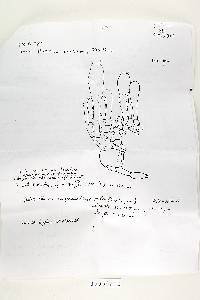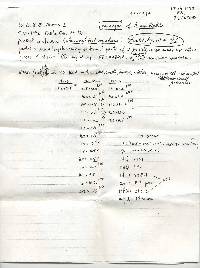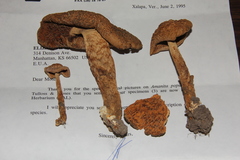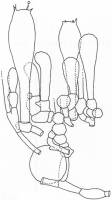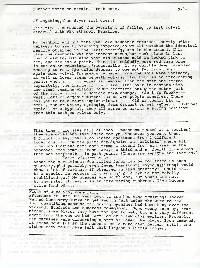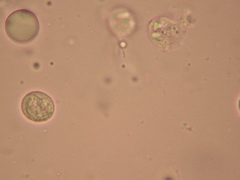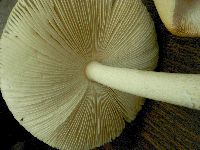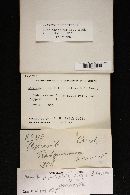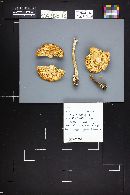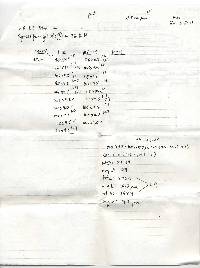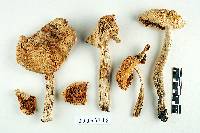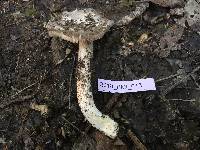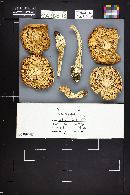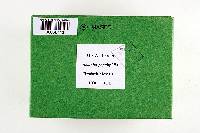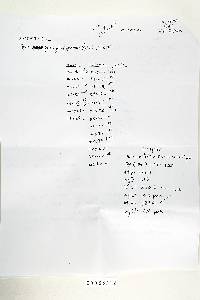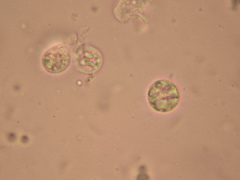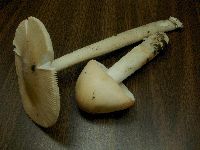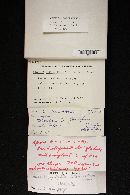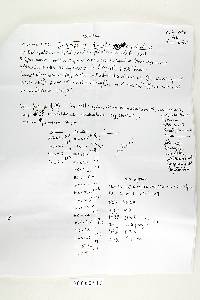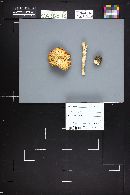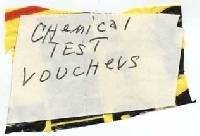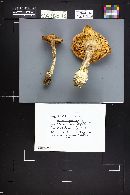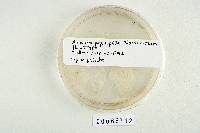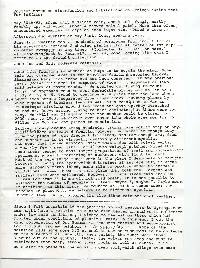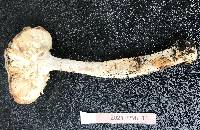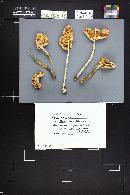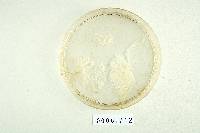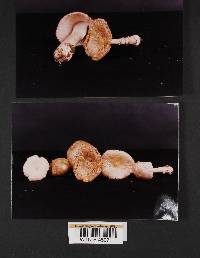
|
|
|
|
Family: Amanitaceae
|
Tulloss RE, Moses E.1995. Amanita populiphila - a new species from the Central United States. Mycotaxon 53: 455-466. Amanita populiphila Tulloss & E. Moses sp. nov. Etymology: Populus + -philo-, loving; hence, Populus-loving because of association with that genus. Pileus 30 - 120 (-135) mm latus, initio albus vel subalbidus vel subalutaceus (disco plus minusve brunneore) deinde subflavidus vel alutaceus vel brunneus, lulae truncatae. Stipes 63 - 175 (-220) x (5-) 7 - 20 mm, albus, exannulatus, velo flavo-brunneo (ubi veto) membranaceo vel submembranaceo et fragmenta vel verrucas vel volvam cupulatum vel saccatum et laxe affixam ad basim stipitis maturi formans. Sporae (7.0-) 9.2 - 12.5 (-21) x (6.0-) 8.2 - 11.2 (-15.8) microns. Fibulae praesentes. Habitat saepe, abundanter Populo in udis vel in sylvis sparsis. Holotypus: U.S.A. Kansas, Pottawatamie Co., N of Manhattan, Tuttle Creek St. Pk, River Pond Area, W. R. & E. Moses s.n. [Tulloss 5-15-92-EM1] (NY). PILEUS: 30 - 120 (-135) mm wide, white to off-white to Tilleul Buff (7.5YR 8.4/2.0), very pale tan (slightly darker over disc) or pale cream (orange-brown tint over disc), often becoming yellowish (e.g., more cream than 5A2 with margin remaining nearly white) to straw-color to tan to brown with age and hadling, tacky to subviscid to viscid (Smith 50210), shiny to dull, broadly campanulate, then convex and broadly umbonate, then plano-convex, in age with margin uplifted; context pure white, unchanging when bruised or cut, 5 - 12.5 mm thick at stipe, thinning evenly for up to four-fifths of radius, then a membrane to margin; margin rather short striate at at least first (0,15+/-R), eventually with longer striation (0.2 - 0.4R) particularly in dry weather, frequently becoming rimose, nonappendiculate; universal veil absent or in often rather thick warts or small patches or a large areolate patch (Smith 84263), submembranous. fragile, detersive, off-white to avellaneous at first, unchanging or becoming yellowish brown or yellowish buff to pale brown to grayish brown to "very dark" (Trueblood 5472) in age or through drying or handling. LAMELLAE: free to adnexed, sometimes with long decurrent very pale orangish white lines on upper stipe, close to crowded, off-white to pinkish white to very pale orangish or pinkish cream in mass, cream to pale cream to sordid pale cream to white in side view, unchanging when cut or bruised, Pale, pinkish or salmon pink (Trueblood 5472)or pale orange to pale yellow-orange when just dried, 3 - 7.5 mm broad, with concolorous to very pale orangish white flocculence on edge; lamellae truncate to excavate-truncate, in several ranks, unevenly distributed, common to plentiful. STIPE: 63 - 175 (-220) x (5-) 7 - 20 mm, white, sometimes with pale watery streaks, not discoloring or becoming watery pale brown over time or from handling, narrowing upward to subcylindric, flaring slightly or not at all at apex, decorated in upper half with very pale orangish white flocculence, finely striatulate; context white to off-white (with watery streaks), usually unchanging when cut or bruised, sometimes sordid in lower stipe or pale tan in universal veil below stipe base, concolorous in larva tunnels, stuffed in whole or part with white cottony fibrils, becoming hollow, with central cylinder 2.5 - 14 mm wide; exannulate; universal veil as 'thimble-like" cuplate volva, suhmembranous to membranous, thin to 3.5 mm or more thick, white, changing with age and drying as on pileus or taking on orange-red or brown spots in lowest portion, easily detached from stipe in mature specimens, frequently also as warts (separate or confluent) unevenly distributed along stipe or in rings around stipe and having form like that of warts on pileus. Odor none (Smith 50210) or mild and pleasantly fungoid or pungent (Smith 84263) in older specimen. Taste mild and pleasantly fungoid in all parts except universal veil (tasteless). EDIBLE (with caution) and good with exception of unavoidably gritty universal veil. MACROCHEMICAL TESTS; Paracresol spot test for tyrosinase - for freshly collected material, rapidly positive throughout basidiocarp in specimens of all stages of development; in material collected 26 hours before testing, reaction took 5 min. Syringaldazine spot test for laccase - negative throughout basidiocarp with exception of exterior surface of undried portions of universal veil at stipe base and there rather rapidly and strongly positive (reddish lavender instantly or in less than 1 min. deepening to near ruby red). 95% ethanol (control for syringaldazine test) - negative in all parts. KOH - negative on pileus and lamellae. NH4OH - very pale yellow on context throughout basidiocarp. Chemical tests performed on holotype and Moses 1. PILEIPELLIS: with rather extensively gelatinized suprapellis colorless and 15 - 45 microns thick, with ungelatinized subpellis yellowish and 135- 200 microns thick; filamentous, undifferentiated hyphae 1.8 - 6.5 microns wide, branching, densely packed, subradially arranged, sometimes with slightly thickened walls; vascular hyphae 2.2 - 17.0 microns wide, common to plentiful, branching, sometimes tightly coiling in part, best seen scalp. PILEUS CONTEXT: filamentous, undifferentiated hyphae 2.8 - 14.8 microns wide, plentiful to dominant, frequently branching, loosely interwoven, only infrequently in fascicles, with walls thin or up to 0.8 microns thick, often constricted at septa, with occasional slightly inflated intercalary segments up to 15.0 microns wide; acrophysalides plentiful elongate to narrowly clavate, up to 121 x 34 microns, with walls thin or up to 0.8 microns thick; vascular hyphae 3.5 - 15.0 microns wide, common, sinuous, occasionally branching; clamps not observed. LAMELLA TRAMA: bilateral, with shallow angle of divergence; was = (50-) 60 - 85 microns when rehydrated well; subhymenial base containing numerous intercalary thin-walled inflated cells [clavate or obclavate to ellipsoid (up to 48 x 21 microns) to fusiform or elongate or allantoid (up to 85 x 20 microns) to (rarely) globose (e.g., 23 x 22 microns)]; filamentous, undifferentiated hyphae 1.5- 11.0 microns wide, branching, with plentiful intercalary partially inflated to subfusiform to fusiform to broadly fusiform to clavevate cells in central stratum (up to 52 x 17.5 microns or larger, becoming disoriented rather easily by sectioning); divergent, terminal, inflated cells not observed; vascular hyphen 2.0 - 4.8 microns wide, sinuous, observed in only one mount (Solheim 5259)—rare. SUBHYMENIUM: wst-near = 40 - 75 microns when rehydrated well; wst-far = 70 - 100 microns when rehydrated well; frequently branching and rather tangled structure of short uninflected or partially inflated hyphal segments and small inflated cells, with basidia arising mostly from uninflected to partially inflated hyphal segments or from uninflected to slightly inflated branched elements, with basidia arising occasionally from small inflated cells; clamps infrequent to rare. BASIDIA: 36 - 83 x 7.8 - 17.8 microns thin-walled, 4- or occasionally 2-sterigmate, with sterigmata up to 8.0 x 5.0 microns; clamps and proliferated clamps scattered (most often found near pileus margin), infrequently locally common. UNIVERSAL VEIL: On pileus: as on stipe base except exterior surface layer sometimes missing, often with much of remainder partially gelatinized; filamentous, undifferentiated hyphae in narrow fascicles than at stipe base and with diameter up to 16.2 microns, with tip cells often somewhat inflated; inflated cells up to 150+/- x 42 microns (almost always less than 65 x 40 microns), common to plentiful, often badly collapsed. At base of stipe, exterior surface: filamentous, undifferentiated hyphae 1.8 - 8.8 microns wide, partially gelatinized to gelatinized, sometimes with walls slightly thickened, almost always in thick criss-crossing fascicles, with occasional slightly inflated terminal segment (up to 10.8 microns wide); vascular hyphae no observed. At base of stipe, interior: filamentous, undifferentiated hyphae 1.8 -14.5 microns wide, frequently branching, dominating, almost always in broad fascicles, with walls up to 1.0 micron thick, with some branches out of fascicles loosely coiling, occasionally having yellowish subrefractive walls; inflated cells unevenly distributed, occasionally in loose clusters (rather commonly in Trueblood 5472), terminal, sometimes dissociated, hyaline, colorless, with walls thin or up to 1.0 micron thick, pyriform to subpyriform to broadly clavate to clavate to elongate-constricted to subfusiform to ellipsoid to ovoid to subglobose, up to 101 x 68 microns (almost always not more than 60 x 40 microns), vascular hyphae not observed; clamps not observed. At base of stipe, inner surface: filamentous, undifferentiated hyphae 1.8 - 10.0 microns wide, branching, densely packed thin layer, longitudinally oriented, partially to extensively gelatinized, aciculate, often with thickened walls; vascular hyphae 5.0 - 8.5 pm wide, in scattered fragments. partially gelatinized. STIPE CONTEXT: longitudinally acrophysalidic; filamentous, undifferentiated hyphae 2.8 - 9.1 microns wide, with thin or slightly thickened walls, very frequently branching, often in rather robust fascicles, plentiful to dominant; acrophysalides plentiful, up to 264 x 42 microns, with walls thin or up to 0.5 microns thick; vascular hyphae 4.5 - 11.2 microns wide, sinuous, scattered, locally common, clamps not observed. BASIDIOSPORES: [1140/57/22] (7.0-) 9.2 - 12.5 (-21) x (6.0-) 8.2 - 11.2 (-15.8) microns, (L = (10.0-) 10.1 - 11.8 (-12.2) microns; L' = 1O.9 microns; W = (8.9-) 9.1 - 10.6 (-11.1) microns, W' = 9.8 microns; Q = (1.0-) 1.04 - 1.20 (-1.61); Q = (1.06-) 1.08 - 1.15 (-1.19); Q' = 1.11), hyaline, colorless, smooth, thin-walled, inamyloid subglobose, occasionally globose, occasionally broadly ellipsoid, infrequently lachrimiform or langeniform, very rarely ellipsoid, often adaxially flattened, often expanded at one end; apiculus sublateral to lateral, small, truncate-conic to cylindric, contents monoguttulate; white in deposit. Distribution and habitat: Idaho: Solitary at 1900+/- m elev. under Populus tremuloides Michx. with (Solheim 5259) or without (Trueblood 5472) nearby conifers. Pottawatomie Co., Kansas: August, 1990: occurring in hundreds (possibly with several mycelia each producing 25 - 150 basidiocarps) covering several acres in mowed field (within flood plain) under P. deltoids Marsh.; with similar large fruiting in September, 1989 (no voucher); with May, 1991 fruiting producing no more than 50 basidiocarps; with no fruiting in August, 1991. In 1992 (with plentiful rainfall and cool weather) fruiting starting in mid-May, with close to 2000 basidiocarps present simultaneously (probably from twenty or more separate mycelia) by early June; with fruiting reduced to several hundred fresh basidiocarps in third week of month: with fruiting continuing with reduction in number and size of basidiocarps until only twenty found on 27 June. [Between 1 July and 25 July 1992, area had 28.8 cm of rain.] 25 July 1992: 200 basidiocarps counted (most smaller than usual). 29 July, 1992: about 100 fresh basidiocarps in main fruiting area with scattered specimens in two other nearby sites. [Temperatures began to rise in late July, 1992 and became very hot in first week of August.] 2 August, 1992: in continuing rain, about 200 basidiocarps found In several sites. 8 August, 1992: about 150 basidioocarps (most smaller than usual) total for all sites. [During mid-August, weather remained hot and became dry.] 18 August, 1992: 12 basidiocarps in main area of occurrence, with 3 in distant site and these with darker than usual disc., 22 August, 1992: no fruiting bodies seen. [July 1992 rainfall (33.6 cm) was third highest recorded for that month for eastern Kansas region in Twentieth Century.] Michigan: Solitary to scattered on moss at edge of bog (Smith 50210). Minnesota: Subgregarious, in dark soil of old lake bottom, under P. tremuloides, in sparsely wooded area containing P. tremuloides, Juniperus, and plentiful young buckthorn (Rhamnus) scrub. New Mexico: Subgregarious to gregarious, in sod of pasture with P. deltoids nearby (Barrows 1090) or in dark wet loam of riparian habitat at 2410+/- m elev. with P. deltoids, Abies, and Acer negundo L. among low cover including "cow parsnip", Rosa, and Spirea (Tulloss 8-15-92-A). Wyoming: In grassy area, under P. tremudoides. Collections examined: U.S.A.: IDAHO—Fremont Co. - Targhee Nat. For., 6.6 km W of Idaho/Wyoming state line, 2.viii.1957 W. G. Solheim 5259 (MICH). Owyhee Co. - Vulcan Crk., 7.vii.1973 Ellen & Ted Trueblood 5472 (MICH). KANSAS—Pottawatomie Co. - N of Manhattan, Tuttle Creek St Pk., River Pond Area, 11-13.vii.1990 W. R. & E Moses s.n. [Tulloss 8-11/13-90-EM1], 25.viii.1990 W. R. & E. Moses s.n. [Tulloss 8-25-90-EM1], 25.v.1991 W. R. & E Moses s.n. [Tulloss 5-25-91-EM1], 15.v.1992 W. R. & E Moses s.n. [Tulloss 5-15-92 EM1] (Holotype, NY; isotype, RET), 22.v.1992 W. R. & E. Moses [Tulloss 5-22-92-EM1], 25.v.1992 W R. & E Moses s.n. [Tulloss 5-25-92-EM1] (L; RET), 30.v.1992 W R. & E. Moses s.n. [Tulloss 5-30-92-EM1], 5.vi.1992 W. R. & E. Moses 1 (NY), 2, 3, & 4. Rooks Co. - Stockton, 1.ix.1908 Elam Bartholomew s.n. (FH as "A. nivalis"). Co. unknown - locality unknown, 18.vi.1967 Harbaugh 67-6-18-1 (MICH). MICHIGAN—Luce Co. - Tahquamenon St. Pk., 22.viii.1965 Alexander H. Smith 50210 (MICH). Oakland Co. - Highland Recreation Area, 22.vii.1973 A. H. Smith 84263 (MICH). MINNESOTA—Washington Co. - Afton, 11.vii.1993 Anna Gerenday 9307. MONTANA—Gallatin Co. - Bozeman, divide btwn. Bridge & Kelly Cyn., 2.vii.1957 F. B. Cotner 570039 (MICH). NEW MEXICO—Colfax Co. - Colin Nesblett Wildlife Area, Tolby Creek, 15.viii.1992 NAMA '92 foray participant s.n. [Tulloss 8-15-92-A]. Rio Arriba Co. - El Rito. viii.1959 Charles Barrows 1090 (MICH). WYOMING—Teton Co. - Grand Teton Nat. Pk., Reid Mtn., 26.viii.1983 Kent H. McKnight & Meinhard Moser [McKnight 83082610] (BPI as "A. alba"). |
|
|
|

